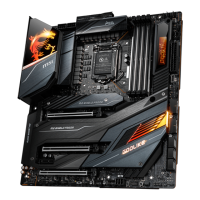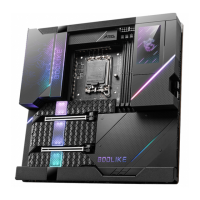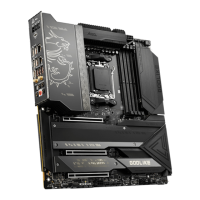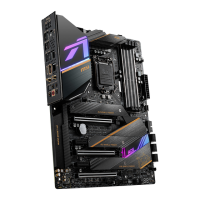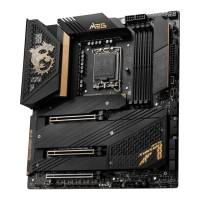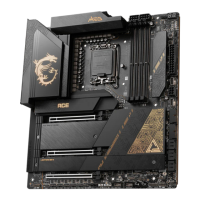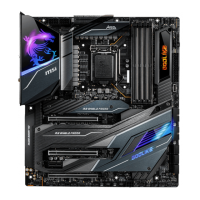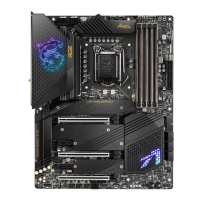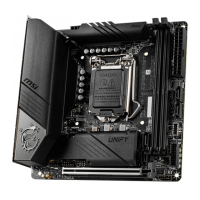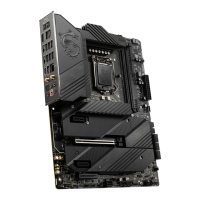
Do you have a question about the MSI MEG Z390 GODLIKE and is the answer not in the manual?
| Processor socket | LGA 1151 (Socket H4) |
|---|---|
| Processor manufacturer | Intel |
| Compatible processor series | Intel Celeron, Intel Core i3, Intel Core i5, Intel Core i7, Intel Core i9, Intel Pentium |
| Maximum number of SMP processors | 1 |
| Audio chip | Realtek ALC1220 |
| Component for | PC |
| Motherboard chipset | Intel Z390 |
| PC health monitoring | CPU, FAN, Temperature |
| Audio output channels | 7.1 channels |
| Motherboard form factor | Extended ATX |
| Number of mounting holes | 9 |
| Windows operating systems supported | Windows 10 Education x64, Windows 10 Enterprise x64, Windows 10 Home x64, Windows 10 Pro x64 |
| Non-ECC | Yes |
| Memory channels | Dual-channel |
| Memory slots type | DIMM |
| Number of memory slots | 4 |
| Supported memory types | DDR4-SDRAM |
| Maximum internal memory | 64 GB |
| Supported memory clock speeds | 2133, 2400, 2666, 2800, 3000, 3200, 3300, 3333, 3400, 3466, 3600, 3733, 3866, 4000, 4133, 4200, 4266, 4300, 4400, 4500, 4600 MHz |
| Number of M.2 (M) slots | 3 |
| RAID levels | 0, 1, 5, 10 |
| Supported storage drive interfaces | M.2, SATA III |
| Parallel processing technology support | 2-Way SLI, 4-Way CrossFireX |
| BIOS type | UEFI AMI |
| ACPI version | 6.1 |
| BIOS memory size | 128 Mbit |
| USB 2.0 connectors | 2 |
| Number of SATA III connectors | 6 |
| USB 3.2 Gen 2 (3.1 Gen 2) connectors | 0 |
| USB 2.0 ports quantity | USB 2.0 ports have a data transmission speed of 480 Mbps, and are backwards compatible with USB 1.1 ports. You can connect all kinds of peripheral devices to them. |
| LAN controller | Killer E2500 |
| Wi-Fi standards | Wi-Fi 5 (802.11ac) |
| Bluetooth version | 4.1 |
| Ethernet interface type | Gigabit Ethernet |
| Cables included | SATA |
| Depth | 272 mm |
|---|---|
| Width | 305 mm |
Instructions to prevent damage from electrostatic discharge and ensure safe handling of components.
Step-by-step guide for installing M.2 SSDs, including thermal pad placement.
Explains hexadecimal characters, boot phases, and SEC progress codes for debugging.
Lists specific error and progress codes for SEC and PEI stages during boot.
Details progress and error codes related to the DXE stage of the boot process.
Lists specific error codes encountered during the DXE phase of system initialization.
Step-by-step guide for installing the Windows 10 operating system.
Instructions for installing essential system drivers and additional software utilities.
Procedures for resetting BIOS to defaults and updating BIOS via M-FLASH or Dragon Center.
Instructions for updating BIOS using the dedicated Flash BIOS button.
Options to select OC modes and apply CPU ratio settings for performance tuning.
Settings for CPU ratio offset, ring ratio, EIST, Turbo Boost, and XMP profiles.
Options for memory timing modes, DRAM voltage control, and CPU specifications.
Settings for Hyper-Threading, CPU core control, CPUID limits, and Intel Virtualization Tech.
Settings for cache line prefetching, AES instructions, C-states, and power limits.
Options for monitoring fan speeds, CPU/system temperatures, and voltages.
Steps to enable RAID functionality and enter the RST menu.
Procedure for creating a new RAID volume with specified name, level, and disks.
Steps to delete an existing RAID volume, noting data loss.
Process to remove RAID structures from drives and reset them to non-RAID status.
Procedure to rebuild a RAID array when a drive has failed or is disconnected.
Guide for installing RAID drivers during OS installation or post-installation.
Lists the prerequisites for installing and using Intel Optane memory.
Final steps to enable Optane memory through the RST application and important cautions.
Procedure to disable and physically remove the Optane memory module.
Solutions for the computer not powering on or showing no display signal.
Troubleshooting steps for boot failures, no audio, network connectivity, and USB device issues.
